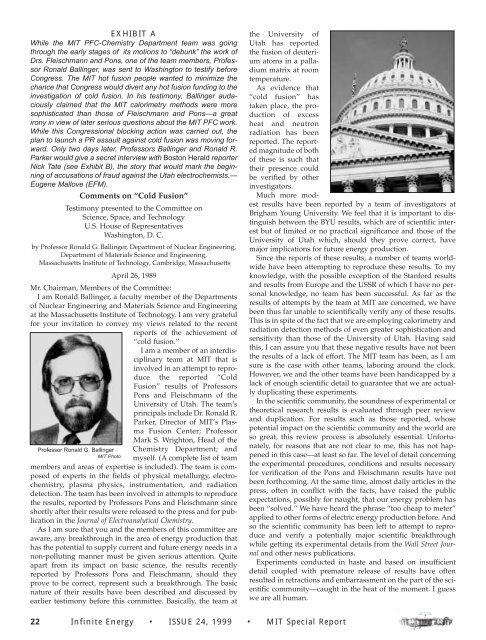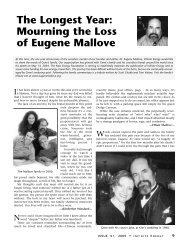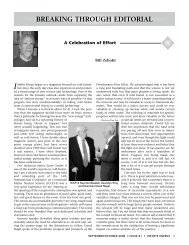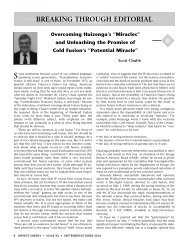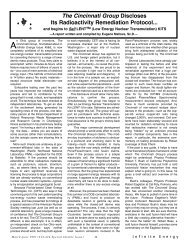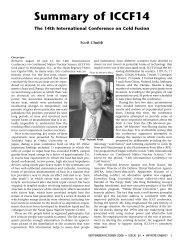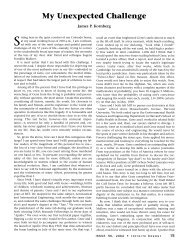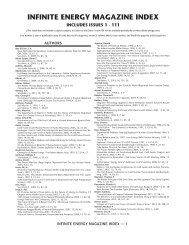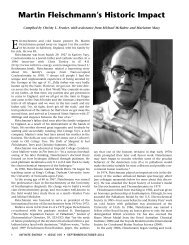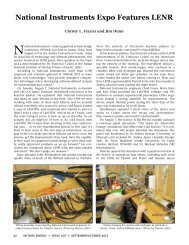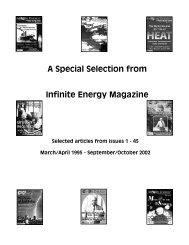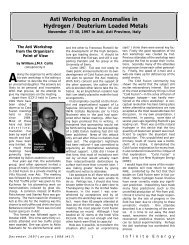MIT and Cold Fusion: A Special Report - Infinite Energy Magazine
MIT and Cold Fusion: A Special Report - Infinite Energy Magazine
MIT and Cold Fusion: A Special Report - Infinite Energy Magazine
Create successful ePaper yourself
Turn your PDF publications into a flip-book with our unique Google optimized e-Paper software.
EXHIBIT A<br />
While the <strong>MIT</strong> PFC-Chemistry Department team was going<br />
through the early stages of its motions to “debunk” the work of<br />
Drs. Fleischmann <strong>and</strong> Pons, one of the team members, Professor<br />
Ronald Ballinger, was sent to Washington to testify before<br />
Congress. The <strong>MIT</strong> hot fusion people wanted to minimize the<br />
chance that Congress would divert any hot fusion funding to the<br />
investigation of cold fusion. In his testimony, Ballinger audaciously<br />
claimed that the <strong>MIT</strong> calorimetry methods were more<br />
sophisticated than those of Fleischmann <strong>and</strong> Pons—a great<br />
irony in view of later serious questions about the <strong>MIT</strong> PFC work.<br />
While this Congressional blocking action was carried out, the<br />
plan to launch a PR assault against cold fusion was moving forward.<br />
Only two days later, Professors Ballinger <strong>and</strong> Ronald R.<br />
Parker would give a secret interview with Boston Herald reporter<br />
Nick Tate (see Exhibit B), the story that would mark the beginning<br />
of accusations of fraud against the Utah electrochemists.—<br />
Eugene Mallove (EFM).<br />
Comments on “<strong>Cold</strong> <strong>Fusion</strong>”<br />
Testimony presented to the Committee on<br />
Science, Space, <strong>and</strong> Technology<br />
U.S. House of Representatives<br />
Washington, D. C.<br />
by Professor Ronald G. Ballinger, Department of Nuclear Engineering,<br />
Department of Materials Science <strong>and</strong> Engineering,<br />
Massachusetts Institute of Technology, Cambridge, Massachusetts<br />
April 26, 1989<br />
Mr. Chairman, Members of the Committee:<br />
I am Ronald Ballinger, a faculty member of the Departments<br />
of Nuclear Engineering <strong>and</strong> Materials Science <strong>and</strong> Engineering<br />
at the Massachusetts Institute of Technology. I am very grateful<br />
for your invitation to convey my views related to the recent<br />
reports of the achievement of<br />
“cold fusion.”<br />
I am a member of an interdisciplinary<br />
team at <strong>MIT</strong> that is<br />
involved in an attempt to reproduce<br />
the reported “<strong>Cold</strong><br />
<strong>Fusion</strong>” results of Professors<br />
Pons <strong>and</strong> Fleischmann of the<br />
University of Utah. The team’s<br />
principals include Dr. Ronald R.<br />
Parker, Director of <strong>MIT</strong>’s Plasma<br />
<strong>Fusion</strong> Center; Professor<br />
Mark S. Wrighton, Head of the<br />
Professor Ronald G. Ballinger<br />
<strong>MIT</strong> Photo<br />
Chemistry Department; <strong>and</strong><br />
myself. (A complete list of team<br />
members <strong>and</strong> areas of expertise is included). The team is composed<br />
of experts in the fields of physical metallurgy, electrochemistry,<br />
plasma physics, instrumentation, <strong>and</strong> radiation<br />
detection. The team has been involved in attempts to reproduce<br />
the results, reported by Professors Pons <strong>and</strong> Fleischmann since<br />
shortly after their results were released to the press <strong>and</strong> for publication<br />
in the Journal of Electroanalytical Chemistry.<br />
As I am sure that you <strong>and</strong> the members of this committee are<br />
aware, any breakthrough in the area of energy production that<br />
has the potential to supply current <strong>and</strong> future energy needs in a<br />
non-polluting manner must be given serious attention. Quite<br />
apart from its impact on basic science, the results recently<br />
reported by Professors Pons <strong>and</strong> Fleischmann, should they<br />
prove to be correct, represent such a breakthrough. The basic<br />
nature of their results have been described <strong>and</strong> discussed by<br />
earlier testimony before this committee. Basically, the team at<br />
the University of<br />
Utah has reported<br />
the fusion of deuterium<br />
atoms in a palladium<br />
matrix at room<br />
temperature.<br />
As evidence that<br />
“cold fusion” has<br />
taken place, the production<br />
of excess<br />
heat <strong>and</strong> neutron<br />
radiation has been<br />
reported. The reported<br />
magnitude of both<br />
of these is such that<br />
their presence could<br />
be verified by other<br />
investigators.<br />
Much more modest<br />
results have been reported by a team of investigators at<br />
Brigham Young University. We feel that it is important to distinguish<br />
between the BYU results, which are of scientific interest<br />
but of limited or no practical significance <strong>and</strong> those of the<br />
University of Utah which, should they prove correct, have<br />
major implications for future energy production.<br />
Since the reports of these results, a number of teams worldwide<br />
have been attempting to reproduce these results. To my<br />
knowledge, with the possible exception of the Stanford results<br />
<strong>and</strong> results from Europe <strong>and</strong> the USSR of which I have no personal<br />
knowledge, no team has been successful. As far as the<br />
results of attempts by the team at <strong>MIT</strong> are concerned, we have<br />
been thus far unable to scientifically verify any of these results.<br />
This is in spite of the fact that we are employing calorimetry <strong>and</strong><br />
radiation detection methods of even greater sophistication <strong>and</strong><br />
sensitivity than those of the University of Utah. Having said<br />
this, I can assure you that these negative results have not been<br />
the results of a lack of effort. The <strong>MIT</strong> team has been, as I am<br />
sure is the case with other teams, laboring around the clock.<br />
However, we <strong>and</strong> the other teams have been h<strong>and</strong>icapped by a<br />
lack of enough scientific detail to guarantee that we are actually<br />
duplicating these experiments.<br />
In the scientific community, the soundness of experimental or<br />
theoretical research results is evaluated through peer review<br />
<strong>and</strong> duplication. For results such as those reported, whose<br />
potential impact on the scientific community <strong>and</strong> the world are<br />
so great, this review process is absolutely essential. Unfortunately,<br />
for reasons that are not clear to me, this has not happened<br />
in this case—at least so far. The level of detail concerning<br />
the experimental procedures, conditions <strong>and</strong> results necessary<br />
for verification of the Pons <strong>and</strong> Fleischmann results have not<br />
been forthcoming. At the same time, almost daily articles in the<br />
press, often in conflict with the facts, have raised the public<br />
expectations, possibly for naught, that our energy problem has<br />
been “solved.” We have heard the phrase “too cheap to meter”<br />
applied to other forms of electric energy production before. And<br />
so the scientific community has been left to attempt to reproduce<br />
<strong>and</strong> verify a potentially major scientific breakthrough<br />
while getting its experimental details from the Wall Street Journal<br />
<strong>and</strong> other news publications.<br />
Experiments conducted in haste <strong>and</strong> based on insufficient<br />
detail coupled with premature release of results have often<br />
resulted in retractions <strong>and</strong> embarrassment on the part of the scientific<br />
community—caught in the heat of the moment. I guess<br />
we are all human.<br />
22 <strong>Infinite</strong> <strong>Energy</strong> • ISSUE 24, 1999 • <strong>MIT</strong> <strong>Special</strong> <strong>Report</strong>


